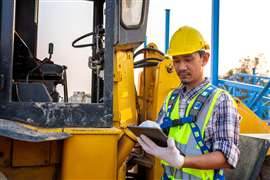Digitisation Dilemma: Why construction must bridge the network gap to meet rising demand
15 July 2025
The construction industry stands to gain from the data centre boom — but chronic underinvestment in site connectivity risks undermining both productivity and safety. Fred Rio, senior vice president of OEM sales at Trackunit argues that as data centres multiply and digitisation becomes critical, construction firms must overcome technical and cultural barriers to unlock the full potential of connected worksites.
 Photo: Adobe Stock
Photo: Adobe Stock
Data connectivity and data centres have become as essential to construction as construction is to the continued growth of data centres.
Certainly, the growing demand for data centres presents a significant opportunity for construction firms. In July 2024 alone, more than US$30 billion in new data centre projects were announced globally — spanning the largest cloud providers to medium and small operators.
Meanwhile, after years of hype, data connectivity in construction remains relatively immature. But it’s becoming increasingly embedded — and will soon strengthen the broader ecosystem by providing the data needed to stay ahead. This includes tracking sites, logistics, materials, and machines, and using that data to analyse and predict potential issues. Already, this is helping to reduce downtime, improve productivity and safety, and keep projects on time and on budget.
Downtime challenges
More robust data and analytics will also help align the objectives of owners and builders — two parties who have traditionally been at odds. Owners want a data centre that best balances cost, schedule, and overall business needs, including uptime. Builders want to meet targets while protecting their margins.
Yet both industries are routinely undermined by the same challenge: downtime.
Construction is a fiendishly complex business, and that very complexity is a barrier to the kind of connectivity that could drive real efficiency. Many sites lack reliable networks. Only those with sufficient capital can implement the gateway hardware needed to establish one.
Currently, it’s estimated that just 5% of sites in Europe, 3% in North America, and 1.5% in South America have an effective connectivity setup. That highlights both the scale of the problem — and the size of the opportunity.
Much attention has rightly been paid to the role of networks in enabling connected jobsites. On many projects, simply moving out of range of the portacabin — with its unreliable Wi-Fi — and losing video or data contact with HQ demonstrates just how valuable dependable network access could be.
 Fred Rio, senior vice president, OEM sales, Trackunit
Fred Rio, senior vice president, OEM sales, Trackunit
Introduce that concept into the physical realities of construction — tunnels, multiple floors, thick walls, and other obstructions — and the implications quickly become clear. But the value isn’t limited to Wi-Fi alternatives. Better connectivity would allow workers to quickly locate tools and equipment, reducing delays from lost or stolen items. It would also enhance understanding of the connectivity needs of the finished building — benefiting not just construction, but also future building owners and users.
This is why connectivity could be the single most impactful development in consigning downtime to the past.
In a recent report, global consultancy McKinsey noted that construction projects typically take 20% longer than scheduled and that up to 80% run over budget — with the slow pace of digital adoption playing a major role. As a result, the industry misses out on the benefits of connectivity that could help optimise planning and reduce delays.
Given this, the case for investment in connectivity seems obvious. But in reality, it’s more complicated.
First, there’s the issue of cost. Whether Mesh, Star, or another topology, networks are not cheap — and implementing one that reliably supports a large site with vertical, subterranean, and scale-related challenges is a significant undertaking.
That said, prices are trending downward as competition grows, and for larger firms, the cost is manageable. This is reflected in the growing use of mesh networks in industries such as oil and gas, tech, and chemicals — a market valued at USD 8.29 billion in 2022 and projected to grow to USD 15.95 billion by 2030 at a CAGR of 8.6%, according to Skyquest.
Star and mesh networks
At the top end of the IoT sector, star-network topologies — in which data flows through a central node — offer one possible solution. Unlike mesh networks, these centralise communication rather than distribute it across many nodes.
Aside from cost and technology barriers, construction also faces a cultural one: decades of overpromising and underdelivering from tech providers have bred scepticism.
That’s where industry leaders come in. Major players such as Bechtel, Mortensen, Kiewit, and Skanska — collectively turning over around US$48.4 billion — are investing heavily in connectivity. As ever in construction, when the leaders move, the rest of the industry tends to follow.
Another factor is IT support. As organisations scale up and down with project demand, they’ll need flexible support arrangements that can adapt accordingly.
 Photo: Adobe Stock
Photo: Adobe Stock
The heavy machinery segment has already embraced connectivity, helping to eliminate cost objections and overcome resistance to change. Familiarity is key, and similar dynamics are now moving down the value chain to medium-sized equipment and smaller firms.
There’s also a clear safety benefit — another major source of downtime. Any incident requiring investigation can shut down an entire site. While safety is non-negotiable, improved connectivity can reduce the likelihood of incidents, strengthening the business case on every front: cost, downtime, and safety.
Technology providers are working with OEMs, rental firms, and contractors on solutions that will, over the next five years, drive the data connectivity, analytics, and insights at the heart of the connected jobsite.
The goal is seamless coordination between people, machines, and processes — enabling a smooth progression from production to finished results: the data centres, schools, hospitals, roads, and infrastructure we all rely on.
We are, in effect, moving toward a powerful combination: high-bandwidth 5G, satellite technologies like Starlink, and hybrid topologies such as Mesh and Star networks. Together, they’re forming an ecosystem that will transform how construction operates.
This is no longer a question of if, but when. And once that shift happens, the jobsite of today may become almost unrecognisable.
STAY CONNECTED



Receive the information you need when you need it through our world-leading magazines, newsletters and daily briefings.
CONNECT WITH THE TEAM








